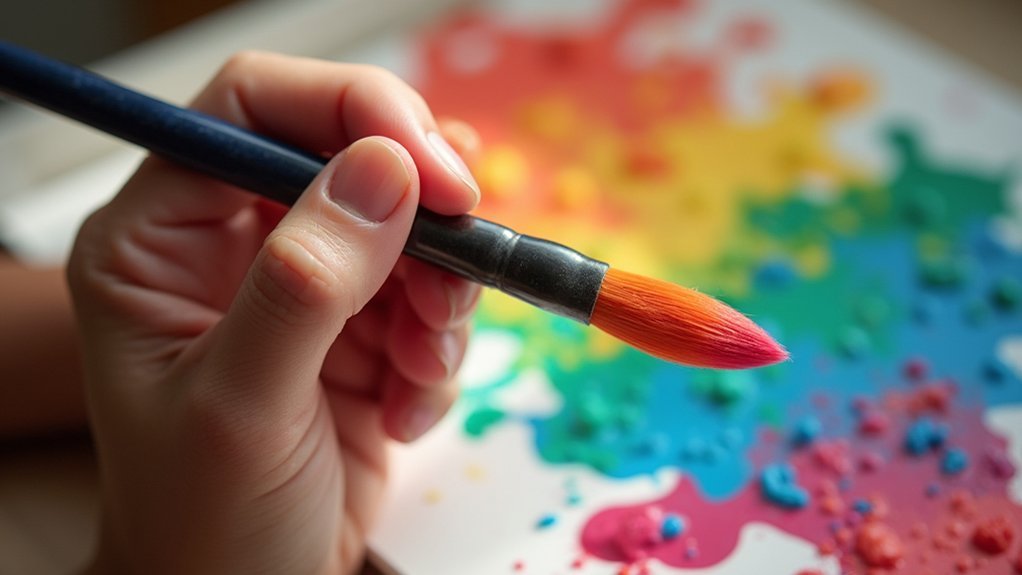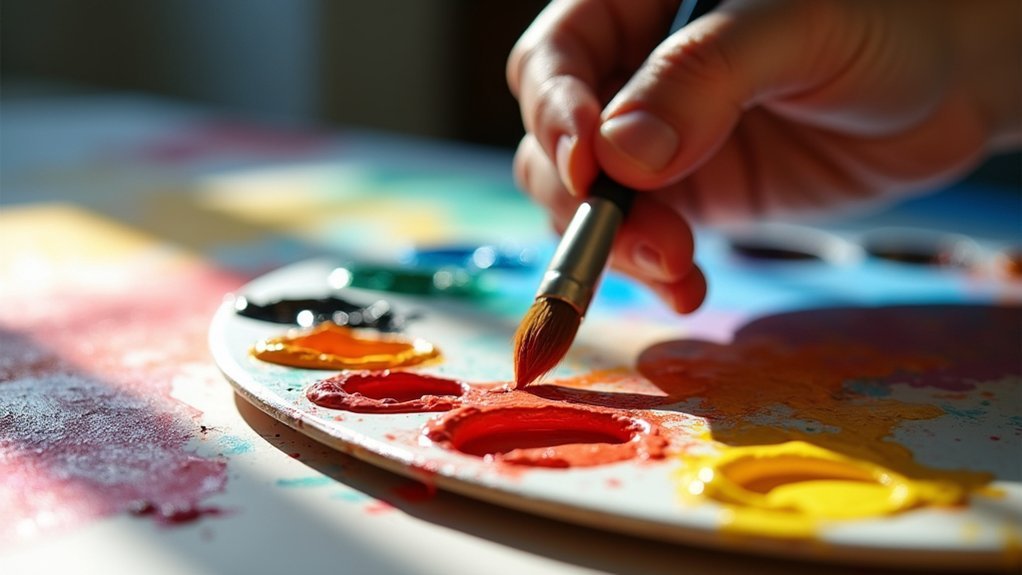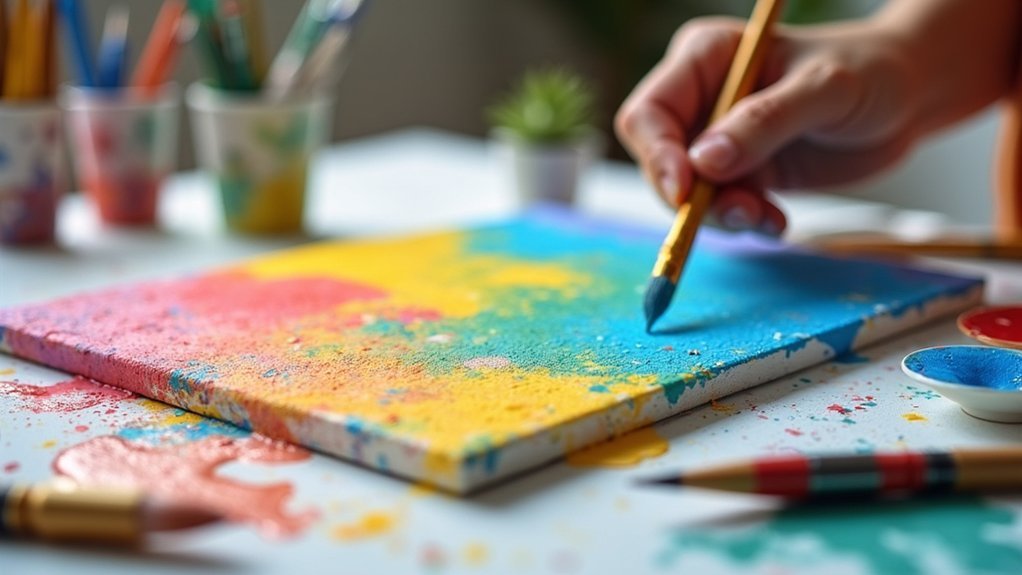To paint with hand tremors, try using larger brushes with wide handles for better grip, create a stable environment with proper supports, opt for thicker paint mediums to minimize shakiness, utilize painter’s tape for clean edges, explore adaptive tools designed for limited dexterity, practice relaxation techniques before sessions, and embrace artistic styles that complement your natural movements. These practical hacks can transform your challenges into unique artistic expressions that reflect your authentic creative voice.
Choose Larger Brushes and Tools for Better Control

The frustration of a trembling hand shouldn’t stop your artistic expression. When tremors challenge your painting experience, go back to basics by selecting brushes with wider handles and thicker grips.
These larger tools distribute pressure evenly across your hand, providing stability when you need it most. Opt for brushes with wider bristles to cover more canvas area efficiently, reducing the need for precise movements.
Take care to explore ergonomically designed options specifically crafted for comfortable handling—they’ll minimize fatigue during longer painting sessions.
Don’t hesitate to experiment with various brush sizes to find what works best for your unique needs. The right painting tools can transform your experience, giving you renewed confidence and control despite hand tremors, allowing your creativity to flow uninterrupted.
Create a Stable Painting Environment With Supports
Beyond selecting the right tools, your painting workspace plays a significant role in managing hand tremors. Start by setting up a sturdy table or adjustable easel that keeps your materials secure and within reach. Place a non-slip mat underneath your canvas or paper to prevent frustrating shifts while you work.
Consider adding physical supports to stabilize your hand movements:
- A cushioned wrist rest positioned along the edge of your work surface to support your forearm as you paint detailed areas
- A weighted brush holder that slips over your existing brushes, adding heft to counterbalance tremor movements
- A custom-angled arm support that cradles your painting arm, reducing muscle fatigue that can worsen tremors
These environmental modifications will create a foundation of stability that complements your adaptive tools.
Opt for Thicker Paint Mediums to Minimize Shakiness

Your paint’s consistency can make a significant difference when managing tremors while creating art.
Thicker paints like heavy body acrylics or those mixed with gel mediums offer more resistance against your brush movements, giving you better control despite shaky hands.
You’ll find that working with these more viscous mediums allows your strokes to remain more deliberate and precise, effectively minimizing the visual impact of tremors in your finished work.
Paint Viscosity Matters
Consistency plays an essential role when painting with hand tremors. Thicker mediums like heavy body acrylics and oil paints provide stability on canvas, giving you better control during application. When your paint has substance, it resists unwanted movement caused by shaky hands, allowing you to create more deliberate strokes.
Try incorporating gel mediums into your paints to increase thickness and enhance grip. This additional viscosity creates a more substantial texture that’s easier to manage with trembling hands.
Palette knives work beautifully with thicker paints, offering controlled application without requiring the steady precision of fine brushwork.
- Rich, buttery paint gliding smoothly across the canvas despite hand movement
- Textured strokes creating intentional, expressive elements rather than accidental marks
- Three-dimensional effects emerging as thicker paint creates natural shadows and depth
Gel Mediums Work Wonders
The transformative power of gel mediums can’t be overstated for artists dealing with hand tremors. These thicker substances create a stable application surface that considerably reduces the impact of unsteady hands on your brushwork.
When you mix gel mediums with your acrylic paints, you’ll gain better control and precision. The increased viscosity prevents unwanted dripping or sliding, allowing you to place paint exactly where you intend.
You’ll also notice enhanced color depth and texture in your finished pieces. The bonus? Gel mediums extend drying time, giving you precious extra minutes to refine details before the paint sets.
Many artists discover that these mediums not only make painting physically easier but also reveal more expressive potential in their artwork despite tremors. Your creative vision needn’t be limited by shaky hands.
Use Painter’s Tape for Clean Edges and Boundaries
Painter’s tape proves to be an invaluable ally for those struggling with hand tremors. By applying it to edges before you begin painting, you’ll create clean, sharp lines without needing steady hands. Press the tape down firmly to prevent paint from seeping underneath, ensuring a professional-looking finish every time.
- Imagine creating perfect geometric patterns across your canvas—triangles, squares, and stripes—all without worrying about your lines wobbling.
- Picture peeling back the tape while paint is still slightly wet, revealing crisp boundaries between colors that look professionally executed.
- Visualize using different tape widths to create varied line thicknesses, adding visual interest and depth to your artwork.
Remove the tape while paint remains slightly wet for best results.
Explore Adaptive Painting Tools Designed for Limited Dexterity

Beyond tape techniques, specialized adaptive tools offer renewed artistic freedom for those with hand tremors.
Look for brushes with enlarged, ergonomic grips that reduce fatigue while improving control and precision during longer painting sessions.
Enlarged, ergonomic brush grips become essential allies, fighting fatigue while enhancing precision throughout extended creative sessions.
Consider investing in stabilizing wrist supports or adjustable easels that provide the extra stability you need to paint confidently.
Customizable paintbrush holders can be fitted to your unique grip requirements, making it easier to achieve your desired strokes without struggling.
Don’t overlook the value of weighted palettes and non-slip surfaces that prevent accidental spills and create a stable foundation for your work.
For different textures and effects, try sponge brushes or rollers—these alternatives require less fine motor control while still allowing you to express your creativity fully.
Practice Relaxation Techniques Before Painting Sessions
You’ll notice significant improvement in your painting stability by practicing deep breathing exercises that calm your nervous system and reduce trembling.
Try incorporating gentle finger and wrist stretches before picking up your brush to enhance flexibility and improve blood circulation to your hands.
Embracing mindfulness meditation or listening to soothing music can sharpen your focus and create the mental stillness needed for steadier brushwork.
Breath Control Reduces Trembling
For artists dealing with hand tremors, breath control can serve as a powerful stabilizing force before you pick up a paintbrush. Deep breathing exercises signal your nervous system to calm down, directly reducing the physiological response that triggers trembling hands. The simple act of inhaling slowly for four counts and exhaling for six can dramatically improve your painting precision.
- Visualize your breath as a gentle tide washing away tension from your fingertips with each exhale.
- Imagine oxygen flowing directly to your hands, creating a warm, steady sensation.
- Picture yourself painting with fluid, confident strokes as you breathe rhythmically.
Try incorporating a 5-minute breathing routine before your painting sessions. You’ll likely notice not just steadier hands, but also enhanced focus and creative flow.
Gentle Stretching Before Artwork
While breath control calms your internal systems, physical preparation relaxes your external muscles for ideal painting stability.
Before you pick up that brush, take five minutes to gently stretch your hands, wrists, and forearms.
Focus on wrist flexor and extensor stretches to enhance flexibility and reduce stiffness. Hold each position for 15-20 seconds while incorporating deep breathing—inhale slowly through your nose and exhale through your mouth. This combination promotes relaxation and improved blood circulation, directly addressing tremor challenges.
Try progressive muscle relaxation by tensing and then releasing each muscle group from your shoulders to your fingertips. This practice calms both mind and body, minimizing tremor impact.
Make these stretches part of your pre-painting ritual to build confidence and comfort that will naturally flow into your creative expression.
Mindfulness Enhances Steadiness
Beyond physical preparation, mindfulness practice serves as a powerful gateway to steadier hands during your painting sessions.
Deep breathing exercises can greatly reduce anxiety that often triggers tremors, allowing you to paint with greater control.
Try incorporating a five-minute meditation before you pick up your brush to improve your overall motor function.
- Visualize yourself painting with smooth, fluid motions across the canvas, reinforcing the neural pathways needed for steadier strokes
- Practice progressive muscle relaxation by tensing and releasing each muscle group from your shoulders to your fingertips
- Focus on your breath while painting, drawing air slowly through your nose for four counts, holding briefly, then exhaling for six counts
Regular mindfulness practice creates lasting improvements in hand steadiness over time.
Embrace Artistic Styles That Complement Natural Movement
Rather than fighting against your hand tremors, embrace artistic styles that work harmoniously with your natural movements.
Try the doodle technique to create organic shapes and asymmetrical designs that don’t require precision but celebrate natural flow.
Layer elements strategically by adding boxes behind leaves or varying panel sizes to shift attention away from any shakiness while adding visual interest.
Embrace strategic layering to transform tremors into compositional advantages that lead viewers’ eyes exactly where you want them.
Opt for thicker lines and unique textures that transform unintended wobbles into intentional artistic expressions.
Experiment with different coloring approaches—blend colors with varying pressure to create depth that draws focus to your color mastery rather than line precision.
Remember, art isn’t about perfection.
When you prioritize enjoyment and self-compassion in your creative process, your authentic artistic voice emerges, tremors and all.
Frequently Asked Questions
How to Stop Shaky Hands Quickly?
To stop shaky hands quickly, take slow deep breaths, rest your arms on a stable surface, avoid caffeine, stay hydrated, and try squeezing a stress ball to relax your muscles and reduce tremors.
How to Deal With Shaky Hands When Drawing?
To deal with shaky hands when drawing, use thicker markers for better grip, rest your hand on a stable surface, make larger motions instead of fine details, and try adaptive tools like weighted pen holders.
How Do You Paint Your Nails With Shaky Hands?
You can paint your nails with shaky hands by stabilizing your dominant hand with your non-dominant one, using wide-grip brushes, resting your arm on a table, and applying a base coat for easier corrections.
How Do You Hide Hand Tremors?
You can hide hand tremors by using adaptive tools with ergonomic grips, wearing weighted wristbands, timing medication effectively, resting your hands on stable surfaces, and choosing activities that don’t highlight your tremor.
In Summary
Your tremors needn’t stop your artistic expression. By implementing these seven practical hacks, you’ll find painting more accessible and enjoyable again. From choosing the right tools to creating stable environments, you’ve got options to manage shakiness. Remember, many famous artists worked with physical limitations. Embrace your unique style—sometimes what we perceive as imperfections create the most authentic and beautiful art. Keep creating!





Leave a Reply